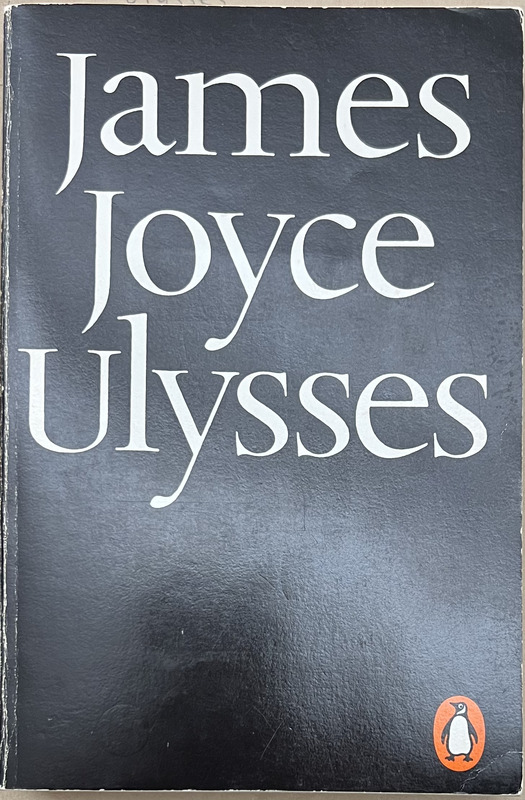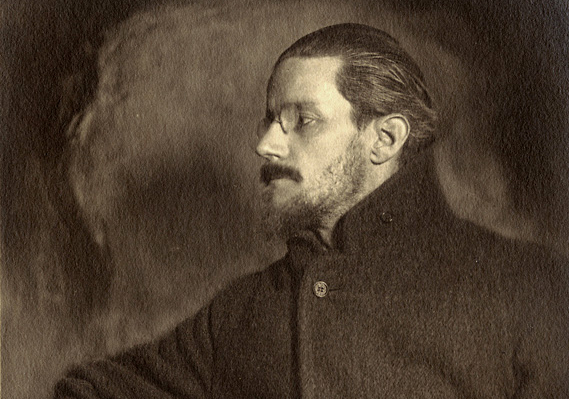Charlotte Saunier (Editions)
Plain Black
Over the course of Ulysses' long and well-known, though not always appreciated life, James Joyce’s novel has been remade and re-published many times. The first whole novel was published in a beautiful blue, vibrant enough to draw the attention of any who passes it. Since then, there have been translations into French, maps drawn of the character's movements in the novel, and many film and movie adaptations. In short, there have been many versions, all more eye-catching than the last. However, in 1969, Penguin Classics came out with its version of the famous novel. With its publication with Penguin Classics, the life of Ulysses was changed, as it was, according to Alistair McCleery, a now “‘safe’ classic of modern literature.” The reason for choosing this specific edition is because it is very similar to the edition my grandfather has passed down to me. With my edition only being published a little under a decade from the 1969 version, there are very few differences that warrant any merit. Same cover and same back cover, save the price differences thanks to the ever-growing steep inflation. The special collection copy is pristine and well preserved. While the one I have has years and years of notes and annotations my grandfather has put in it. It has ripped edges and Sharpie filling in all the cracks to make it look new again. Seeing the novel sitting and collecting dust on my grandfather's bookshelf for many years may have caused me to be a bit more partial to the black and white novel, but it was mostly how bland it looked. After hearing so many stories and tales of this novel, one would think the cover would be a bit more showy. Ulysses' debut from Penguin Classics was plain, to say the least. Gone was the beautiful royal blue and graphics other publications had released, and in its place, we got black with what looks like Times New Roman font in white, and let us not forget the little orange penguin in the bottom right side of the cover. In a few words, Penguin Classics could have done better…But what if that was the point? To be as inconspicuous as possible so that it transformed from this obstacle of a novel to something more approachable and perhaps familiar. The obvious plain-looking novel may not be eye-catching to others who have no clue what the title Ulysses followed by the name James Joyce, but to those who do, they know that the cover is misleading. On the back, however, there is an illustration on Joyce. It is not anything overly special, merely a sketch of the deceased author, but it is a nice touch to the otherwise bland-looking novel. The popularity of the novel amongst students in the United Kingdom surprisingly went up when it was published by Penguin Classics, according to McCleery. For those students, the cover might not have meant much, it solely being one extra page to turn before reaching the gold that is the book's contents, but for others, that cover may be the sole reason they picked up the novel.
Family and Father Portrayal
Looking at Ulysses and research that spans from the epic poem that was the muse of Joyce’s famous novel, the characters in the novel, and to even the family of Joyce himself. Using these resources, we are able to see the way in which relationships, particularly paternal and familial ones, are portrayed and utilized to tell the story of Ulysses. In 1975, James McDonald and Norman McKendrick offered their insights into familial relationships in the novel in correspondence with the original muse, the Odyssey by Homer. “In Homer's poem, the family is always and everywhere aristocratic,” and, that “[t]he modern Odysseus, Bloom, is thoroughly bourgeois,” as stated by McDonald and McKendrick. McDonald and McKendrick believe that the reason for the type of relationships in Ulysses was because of, “[Joyce’s] feeling of a spiritual kinship with the Jews,” (McDonald and McKendrick 145). As the Jewish people displayed healthy relationships, Joyce wanted to replicate that with his own family, as well as the families in his novels. The idea of fathers and fatherhood/motherhood is an occurring theme throughout Ulysses. Eleanor Lavan touched on the rise and fall of fatherhood within Stephen Dedulas, as it was the path his father set in motion that dooms him for failure: “Joyce's Stephen Dedalus was familiar with a similar shirking of paternal responsibility…Dedalus' father Simon begins to fall apart when the family fall in social standing,” (Lavan 515). This perpetuates the beliefs in Ulysses that in order to be a good father, one must be in good social standing. And with Bloom as a middle-class Jew in a thriving city such as Dublin, it is no surprise that he refuses to father children. Save the few children he, questionably “has,” later in the novel when he becomes a mother, but again, there is a disconnect from fatherhood that Joyce actively portrays.
The portrayal of family relationships in Ulysses is explored further with the help of Terrence Doody and Wesley Morris in their article “Language and Value, Freedom and the Family in Ulysses.” Doody and Morris go on to say that, “. . .fertility is clearly not Joyce's first concern,” when it comes to the novel (227). In Ulysses, Molly and Bloom have sex, and they do not shy away from it within their marriage. However, what they do shy away from is sex with the possibility of children. Bloom refuses to give in to any paternal instinct he may have, and would much rather be a mother, as expressed in the episode Circe: “I so want to be a mother,” (Joyce 465). The idea of paternity is so frightening to Bloom and he does everything in his power to avoid it, which can be attributed to the relationship he had with his own father. In the article “Stephen's "Allwombing Tomb": Mourning, Paternity, and the Incorporation of the Mother in Ulysses,” Joseph Volente had something interesting to say, “the law of the father is enacted by the figure of the mother,” (Volente 12).
The familial and paternal relationships in the novel are extremely complex and convoluted, with little explanation as to why. Thankfully, by looking at the research others have done, the hints throughout the novel meld into an answer.
The Recognizable Made Indistinguishable
When it comes to Ulysses by James Joyce, one could say that there is nothing subtle about it. From the obscene language to the wacky and sometimes confusing writing, to the story itself, not much of the infamous novel is left to the imagination. It is all laid bare for any keen eyes daring to rise to the challenge. However, in the 1960s editions published by Penguin Classics, the flashy and bright cover that one would assume to be there is missing. There are many reasons the cover may have been made more obscure, but the reasoning in this paper is to make it indistinguishable. Ulysses was not the only novel published by Penguin Classics in the 1960s, but it was different from others in the sense that the cover was plain black with white text. When you look up all the covers of Ulysses, you are showered in bright colours and abstract art that jumps out to you. For example, the Vintage Classics edition of the famous novel has both of the elements above. It is an edition that would not be easily forgotten about and it would catch eyes. Is that not what Ulysses is? A jumbled mess of words that spew colour and abstract ideas that make it hard to keep up. An example of this jumble of things happening all at once is the entirety of the episode Circe, where five pages of the novel corresponded to only one second passing in some cases. As the saying goes “never judge a book by its cover,” but it is nearly impossible when the cover is so recognizable; the constant bright colours and art make it easy to spot. Alistair McCleery touched upon this edition of the novel in his work “The 1969 Edition of Ulysses: The Making of a Penguin Classic.” As McCleery stated, “after the Penguin paper back edition…, Ulysses was regarded as a "safe" classic of modern literature,” (McCleery 67). The “safe” edition in question is the black cover, but how can the cover make such a difference? The actual contents of the novel remained the same. If people can not tell what it is someone is reading, if it looks plain and uninteresting, only those privy to the contents would know what is inside. Those who do not know what is inside the plain novel are also more likely to purchase the novel and are thus not deterred from it, as there is no outward offence from it. “[E]mpty the pisspots in the different rooms…rinse the seven of them well, or lap it up in champagne,” is an instance of a scene that one would likely not think would come from a novel with a black cover (Joyce 492). All the perverse and horrid fantasies that Joyce, or rather Bloom, has is still there, just hidden.
There is nothing about Joyce’s Ulysses that is subtle. It is a big and boisterous novel that leaves little to the imagination. The critical design option for this edition of the novel was needed for this particular success. No longer was it ridiculed and hated and banned to the extent that it once was. It was allowed to be read and seen by anyone, and that is the hope for any novel and author.



